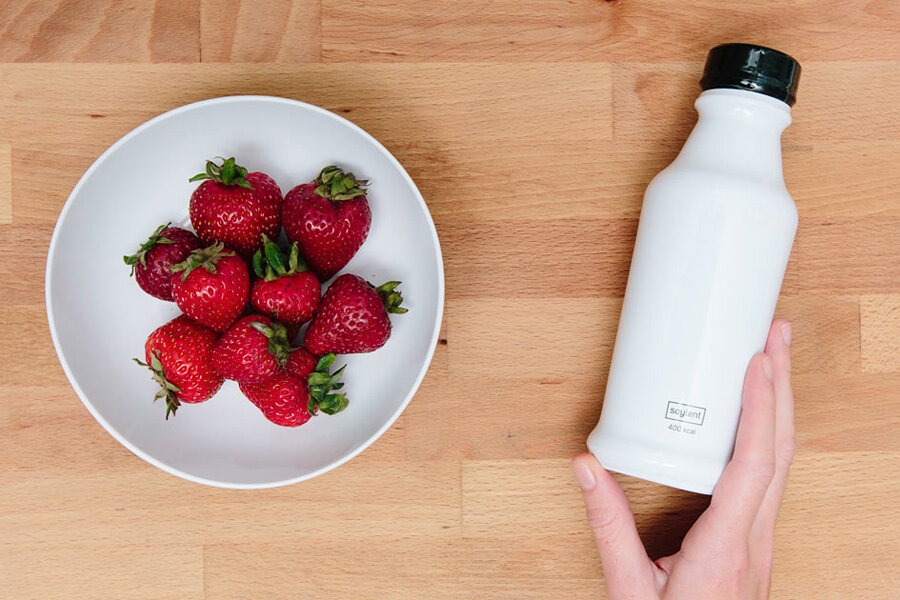Drinkable meals with audience appeal: Soylent's scene is people
Loading...
The next-generation food startup Soylent is releasing a bottled version of its powdery just-add-water meal substitute, aptly named Soylent 2.0.
The new product contains the same nutritional value as the original, pre-watered version, but with a slightly altered formula that Rob Rhinehart, chief executive officer of Soylent-manufacturer Rosa Labs, says will incorporate algae. Soylent 2.0 will be available in October.
“It's really designed in a much different fashion,” Mr. Rhinehart, who created the product in 2013 as a way to nutritionally and affordably streamline food consumption for the busy schedule, tells The Verge.
Though the new bottled version is being compared to existing food substitutes such as Ensure or Boost, Rhinehart notes that Soylent differs by acting as an entire meal substitute, rather than a periodic supplement. Those types of ready-to-go meal substitutes tend also to be fairly expensive or not completely nourishing, two qualities Soylent tries to fix.
“They're really not sustainable,” Rhinehart tells The Verge. “I mean, they're loaded with sugar, they're just way too sweet, and they don't really have the macronutrient balance or the glycemic index that I would feel comfortable sustaining myself on or a user on.”
Soylent is classified by the Food and Drug Administration as a food product, rather than a dietary or nutritional supplement. The company advertises itself as a “meal replacement” and touts that consumers are able to drink Soylent for all meals and gain the required nutritional impact. For the most part, current consumers tend to just use Soylent as a replacement for some – but not all – meals. This has no reflection on the product itself, though, which nutritionists have said solves all dietary needs of the consumer with no known adverse side effects.
Since “The Jetsons,” the search for the ready-to-eat, dinner-in-a-pill style of easy, healthy, and affordable meals has been a center for a small community. Though very few of the products have caught on globally, the popularity of Tang, Ensure, and now Soylent show that society is still looking for some type of global solution to the complex meal.
It makes sense. The average American spends $151 a week on food. Though the United States only spends 6.5 percent of disposable income on food, many other countries spend upward of 30 percent, according to US Department of Agriculture estimates. Americans spend about 30 minutes a day on meal preparation, and in many countries, that time is longer. To figure out some way to not only reduce the time, but the cost, of food would be a key step in securing economic stability for many struggling to afford a healthy meal.
Soylent is also interested in figuring out how to help serve a meal that doesn’t go bad.
“Shipping around water is a little inefficient,” Rhinehart tells The Verge. “However, we counter that by the fact that the drink does not require refrigeration and also does not spoil until at least one year. Given the amount of food that is thrown away, that spoils, and the unconscionable amount of energy that we spend on refrigeration in the United States, I think that it's still a vast resource savings over the majority of the food system.”
But even though Soylent has marketed itself somewhat in an humanitarian light, with some lauding it “the end of food,” there are some hiccups in its consumption. It should first be stated that Soylent (with a capital S) is different from soylent (with a lowercase s), the synecdoche representing all powdery and similar food supplements. Secondly, though there are differences in the various types of products (cost, ingredients, marketing), they all tend to appeal to a very similar demographic.
For that, it’s important to note who, exactly, is using soylent; where it’s available; and how much it costs. Currently, Soylent is only available in the United States and Canada and 84 percent of all soylent users are male, according to the 2015 soylent eaters survey conducted by Ketosoy, a ketogenic meal replacement shake originally created as a do-it-yourself soylent.
Because the company, the product, and the industry are built out of the Silicon Valley startup scene, the user base tends to align with demographics already included by that culture: generally white, male, upper-middle class.
For all its global rhetoric, this makes the concept difficult to spread outside its limited communities that are still struggling to diversify and market outside of themselves.
Soylent (capital S) hopes that its new 2.0 will allow it to appeal to non-loyal users or those outside of the startup scene who are familiar with comparable bottled meal substitutes. However, at this time, the company has no plans to sell Soylent in stores and instead operates as an online purchase or subscription model.
In addition to problems the company faces with marketing the creation of the product itself, those with some dietary restrictions may not be able to use it. Though it’s vegan, Soylent is not organic, not kosher, and not gluten-free. Some have also said that it doesn’t provide the proper dietary breadth for the average healthy American.
Other people and companies making soylent shakes have been able to appeal to consumers looking for a meal replacement but facing dietary restrictions. While Soylent focuses on affordability and base nutrition, some creators focus on making their drink healthier or more varied or for different people with dietary restrictions.
Soylent’s “DIY Soylent” section allows for recipes involving its product from the community, some of which offer new flavors, added nutrition, or tips on how to live off the product.
Rhinehart says he mostly subsists off the product; between 80 and 90 percent of his diet is Soylent, he says.
“I've largely switched to the drink,” he says. Since Soylent 2.0 doesn’t need to be refrigerated until opened, Rhinehart says he’s also gotten rid of his refrigerator.
The powdered version of the product, more efficient and easier to package than the 2.0 version, is expecting its own reboot later this year.
“The philosophies of the nutrition are of course the same: we’re seeking to provide full daily value requirements in a sustainable fashion,” Rhinehart tells Ars Technica.






